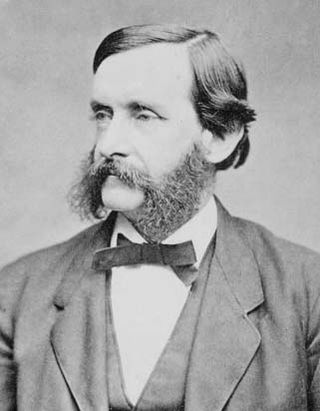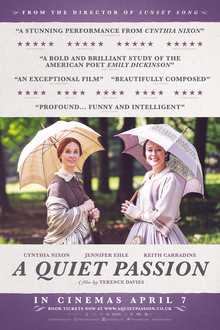Related Research Articles

Waylon Joseph Smithers Jr., usually referred to as Mr. Smithers, or simply Smithers, is a recurring character in the animated sitcom The Simpsons, voiced by Harry Shearer. He first appeared in "Homer's Odyssey", although his voice could be heard in the series premiere "Simpsons Roasting on an Open Fire". He is the consummate executive and personal assistant of Springfield Nuclear Power Plant's owner Mr. Burns, and is usually treated unfairly.

Emily Elizabeth Dickinson was an American poet. Little-known during her life, she has since been regarded as one of the most important figures in American poetry. Dickinson was born in Amherst, Massachusetts, into a prominent family with strong ties to its community. After studying at the Amherst Academy for seven years in her youth, she briefly attended the Mount Holyoke Female Seminary before returning to her family's home in Amherst. Evidence suggests that Dickinson lived much of her life in isolation. Considered an eccentric by locals, she developed a penchant for white clothing and was known for her reluctance to greet guests or, later in life, even to leave her bedroom. Dickinson never married, and most of her friendships were based entirely upon correspondence.
This article contains information about the literary events and publications of 1886.

Josiah Gilbert Holland was an American novelist, essayist, poet and spiritual mentor to the Nation in the years following the Civil War. Born in Massachusetts, he was “the most successful man of letters in the United States” in the latter half of the nineteenth century and sold more books in his lifetime than Mark Twain did in his.

Thomas Wentworth Higginson, who went by the name Wentworth, was an American Unitarian minister, author, abolitionist, politician, and soldier. He was active in abolitionism in the United States during the 1840s and 1850s, identifying himself with disunion and militant abolitionism. He was a member of the Secret Six who supported John Brown. During the Civil War, he served as colonel of the 1st South Carolina Volunteers, the first federally authorized black regiment, from 1862 to 1864. Following the war, he wrote about his experiences with African-American soldiers and devoted much of the rest of his life to fighting for the rights of freed people, women, and other disfranchised peoples. He is also remembered as a mentor to poet Emily Dickinson.

Jerome Charyn is an American writer. With nearly 50 published works over a 50-year span, Charyn has a long-standing reputation as an inventive and prolific chronicler of real and imagined American life, writing in multiple genres.

The Emily Dickinson Museum is a historic house museum consisting of two houses: the Dickinson Homestead and the Evergreens. The Dickinson Homestead was the birthplace and home from 1855 to 1886 of 19th-century American poet Emily Dickinson (1830–1886), whose poems were discovered in her bedroom there after her death. The house next door, called the Evergreens, was built by the poet's father, Edward Dickinson, in 1856 as a wedding present for her brother Austin. Located in Amherst, Massachusetts, the houses are preserved as a single museum and are open to the public on guided tours.

Alice Stuart Parker Pyle, known professionally as Alice Parker, was an American composer, arranger, conductor and teacher.

Mabel Loomis Todd or Mabel Loomis was an American editor and writer. She is remembered as the editor of posthumously published editions of Emily Dickinson's poetry and letters and also wrote several novels and books about her travels with her husband, astronomer David Peck Todd, as well as co-authoring a textbook on astronomy.

"Success is counted sweetest" is a lyric poem by Emily Dickinson written in 1859 and published anonymously in 1864. The poem uses the images of a victorious army and one dying warrior to suggest that only one who has suffered defeat can understand success.

Susanna Mary Clarke is an English author known for her debut novel Jonathan Strange & Mr Norrell (2004), a Hugo Award-winning alternative history. Clarke began Jonathan Strange in 1993 and worked on it during her spare time. For the next decade, she published short stories from the Strange universe, but it was not until 2003 that Bloomsbury bought her manuscript and began work on its publication. The novel became a best-seller.
Cyrus Haley was a New Zealand arsonist. He was born in Leeds, Yorkshire, England on 22 September 1832 and migrated to Auckland, New Zealand, in 1870.

Writers' homes are locations where writers lived. Frequently, these homes are preserved as historic house museums and literary tourism destinations, called writer's home museums, especially when the homes are those of famous literary figures. Frequently these buildings are preserved to communicate to visitors more about the author than their work and its historical context. These exhibits are a form of biographical criticism. Visitors of the sites who are participating in literary tourism, are often fans of the authors, and these fans find deep emotional and physical connections to the authors through their visits.

The literature of New England has had an enduring influence on American literature in general, with themes such as religion, race, the individual versus society, social repression, and nature, emblematic of the larger concerns of American letters.
Jaime Clarke is an American novelist and editor. He is a founding editor of the literary journal Post Road and co-owner, with his wife, of Newtonville Books, an independent bookstore in Boston.

A Quiet Passion is a 2016 British biographical film written and directed by Terence Davies about the life of American poet Emily Dickinson. The film stars Cynthia Nixon as the reclusive poet. It co-stars Emma Bell as young Dickinson, Jennifer Ehle, Duncan Duff, and Keith Carradine. The film premiered at the 66th Berlin International Film Festival in February 2016 and was released in the United Kingdom on 7 April 2017. It won the Grand Prix at Film Fest Gent in 2016.
Otis Phillips Lord was a Massachusetts lawyer and politician who served as a justice of the Massachusetts Supreme Judicial Court from 1875 to 1882. He was appointed by Governor William A. Gaston. In addition to his public roles, he is suspected of having been a lover of Emily Dickinson in her later life.
The Phoenix Hotel was one of the most popular social spots in Dedham during the 19th century. It was located on the northwest corner of the High Street-Washington Street intersection in modern-day Dedham Square. Among the distinguished guests of this hotel were Andrew Jackson and James Monroe.
Brock Clarke is an American novelist, short story writer, and essayist. His work is known for its satirical, sometimes surreal exploration of the lives of average Americans and the role of fiction in society.
References
- ↑ "Brock Clarke". Bowdoin College . Retrieved April 17, 2016.
- ↑ "An Arsonist's Guide to Writers' Homes in New England". Official website. Retrieved April 17, 2016.
- ↑ Humphrey, Charlie (September 2, 2007). "'An Arsonist's Guide to Writers' Homes in New England' by Brock Clarke". Pittsburgh Post-Gazette . Retrieved April 17, 2016.
- ↑ Charles, Ron (September 2, 2007). "Hearts Afire". The Washington Post . Retrieved April 17, 2016.
- ↑ Maslin, Janet (September 10, 2007). "Burn Down a Poet's House, and the Mail Just Pours In". The New York Times . Retrieved April 17, 2016.
- ↑ Wyman, Anne Julia (September 14, 2007). "Onetime teenage arsonist tries to escape his incendiary past". San Francisco Chronicle . Retrieved April 17, 2016.
- ↑ Sellek, Mark (May 31, 2008). "An Arsonist's Guide to Writers' Homes in New England, By Brock Clarke" . The Independent . Archived from the original on May 5, 2016. Retrieved April 17, 2016.
- ↑ Sansom, Ian (May 16, 2009). "An Arsonist's Guide to Writers' Homes in New England". The Guardian . Retrieved April 17, 2016.
- "An Arsonist's Guide to Writers' Homes in New England", St. Louis Dispatch.